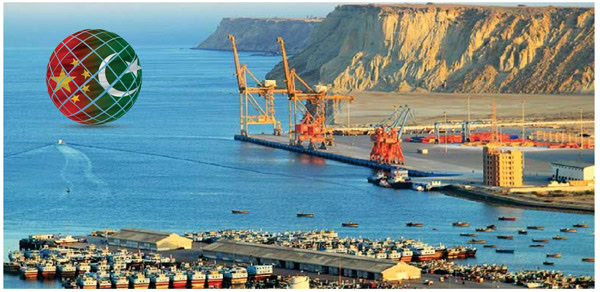Blue economy as a panacea for Pakistan’s staggering economy
Pakistan’s economy has been grappling with high levels of debt and an increasing risk of default along with numerous other economic challenges including persistent inflation, slow growth and high debt levels. However, the blue economy holds the potential to provide a much-needed boost to the country’s economy and help it overcome its current challenges.
The blue economy encompasses the sustainable use of ocean-based resources and activities, including fishing, shipping, tourism, marine resources, renewable energy and many others. As a country with a long coastline along the Arabian Sea, Pakistan has a rich maritime domain that can be leveraged to drive economic growth. However, Pakistan lags behind India and Bangladesh in terms of blue economy revenue, earning only $450 million annually compared to billions earned by its neighbors.
Pakistan’s untapped blue economy holds immense potential to transform its economic landscape. Its strategic coastal location, vast maritime resources and rich natural heritage provide a unique platform for economic growth and prosperity. The country’s 1050 km of coastline, Exclusive Economic Zone spanning 240,000 sq. km, and 50,000 sq. km of continental shelf position it as a hub for maritime trade in the Indian Ocean Region. The ongoing development of Gwadar port under CPEC, a flagship project of the Belt & Road Initiative (BRI) positions Pakistan as a key player in the region, making it a prime destination for investment and development in the blue economy sector. With an estimated worth of over $100 billion, Pakistan’s blue economy has the potential to ignite an economic revolution, driving the country towards a brighter future.
Pakistan holds a strategic position in the Indian Ocean region, with its extensive sea routes serving as a vital hub for international trade and commerce. The country heavily relies on its shipping industry, with over 90% of its trade volume being transported through the sea. However, despite an impressive annual seaborne trade volume of over 94 million tons in 2020, the Pakistan National Shipping Corporation (PNSC) only handled 9.33% of it. This leads to an estimated loss of 5 billion USD in freight charges paid to foreign vessels. The revenue from the sea transport system can be significantly improved with the government playing an instrumental role by enhancing its ships fleet and increasing the sector’s contribution to the GDP. The PNSC has demonstrated its potential for growth, as evident from its 2020 net profit of PKR 2,414 million and 10% increase in taxes and dividends paid to the government. This highlights the immense potential of the shipping industry in Pakistan, which with proper investment and support, can bring significant economic benefits to the country.
Pakistan has enormous potential in marine tourism, with a picturesque coastline and a wealth of natural, cultural and religious tourism resources. Despite the recognition of tourism as an industry by the federal government in the late 80s and efforts to develop the sector, it remains underdeveloped due to political instability, poor governance and security concerns. In comparison, neighboring countries, for instance India, have leveraged their coastal assets to grow their tourism industry, leading to increased foreign exchange and revenue. To unlock the potential of marine tourism in Pakistan, the government must focus on developing a wide range of activities such as boat tours, marine sports, beach development and other water-based recreation. To attract investment, the government must incentivize with tax breaks, high profit margins, streamlined documentation processes and security guarantees. By maximizing the potential of marine tourism, Pakistan has the opportunity to improve the standard of living for coastal communities and increase its earning potential.
In addition to these established sectors, there are many other areas of the blue economy that have great potential for Pakistan, such as the marine fishing industry. Despite its vast resources and potential, the fishing industry in Pakistan accounts for a mere 0.4% of its GDP. The high costs associated with the fishing industry have impacted its profitability, putting it behind its neighboring countries in terms of aquaculture production. The post-harvest processing sector in Pakistan is also underdeveloped, with outdated and undercapitalized fish processing facilities. It is imperative that the government and private sector work together to harness the full potential of Pakistan’s rich maritime resources and tap into its untapped potential to drive growth, create jobs and drive sustainable development.
In conclusion, the blue economy has the potential to play a crucial role in addressing Pakistan’s debt woes. By leveraging its maritime domain and investing in sustainable ocean-based activities, the country can drive economic growth, create new jobs and generate new revenue streams. While the blue economy may not be a silver bullet solution to all of Pakistan’s financial challenges, it is certainly a promising avenue worth exploring to help the country overcome its debt problems and achieve long-term economic stability. It is the high time for Pakistan to embrace its blue potential and work towards sustainable policies and strategies that promote the growth of its blue economy. By doing so, its coastal areas will no longer be viewed as vast and empty wilderness, but as a source of prosperity and well-being for all its citizens. Not only this but also investing in the blue economy can help diversify Pakistan’s economy and reduce its dependence on traditional sectors, such as agriculture and manufacturing. This can help the country become more resilient to economic shocks and provide new sources of growth.









